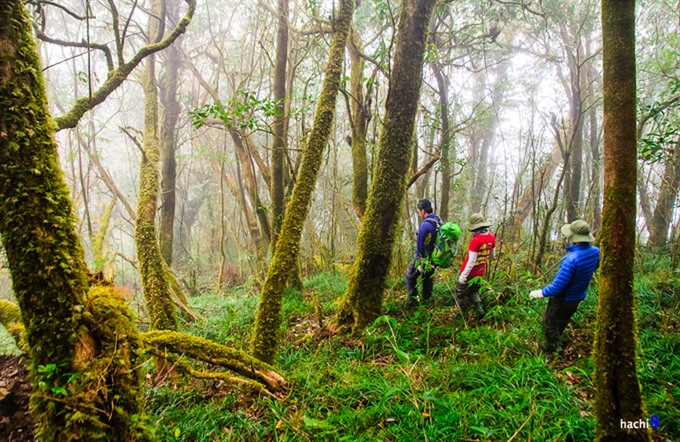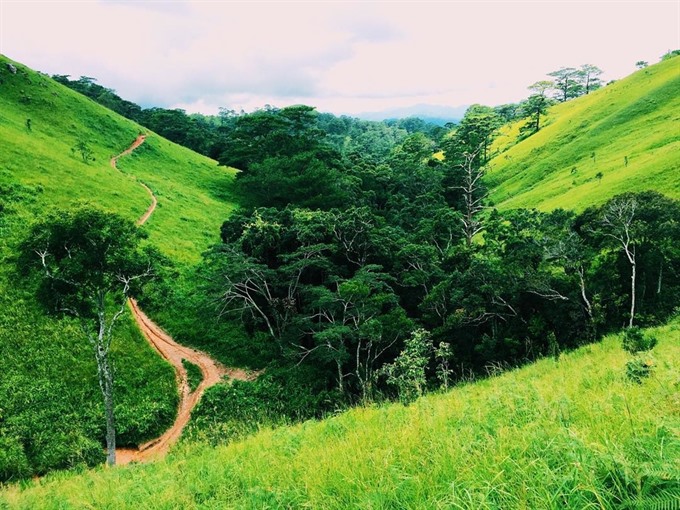Viet Nam News
By Phu Son
At the height of more than 3,000 metres above sea level, Pu Si Lung in Lai Chau Province is known as the third highest mountain peak in Viet Nam, after Fanxipan in Lao Cai and Putaleng in Lai Chau. Though it ranks third, it is known to have the toughest route for trekkers.
The death-defying trails, exhausting trekking and the authenticity of local ethnic people made it a road trip unlike any other.
The peak is located in Muong Te of Lai Chau Province near the border with China. One needs to apply for permission from the Lai Chau Military Staff Committee to go to the mountain peak. They then assign someone to assist trekkers during their trip.
“The road leading to the peak is not easy at all,” said Quach Van Thao, a worker at the guard station. “It is steep. Many groups come to our office. At the beginning they were all very excited, but after seeing the conditions with their own eyes they gave up.”
Our goal is not only to make it to the top of the mountain, but also to see and experience the hardships that have become a part of the daily lives of local residents, soldiers and teachers.
We woke up early in the morning. With the companionship of the local border soldiers, we drove our motorbike from the guard station to Sin A Chai, a death-defying route. This was our first challenge.
 |
| Perseverance: Conquering Pu Si Lung Peak is a mental and physical challenge. |
Some parts of the road were tough. It was just a few metres wide, filled with mud and rocks. On one side was the seemingly vertical mountain, while the other side had a dizzyingly high cliff.
Driving on this route was like running a marathon while lifting weights. Most of the time, we had to push the heavy motorbike through rocks that had covered the road in a landslide. In some bad sections, we even had to carry the motorbike.
Our companion from Pa Ve Su guard station, Hoang Van Lich, said he and his colleagues have to go back and forth on this route a few times every week.
And so do the local people. It made us feel a bit shamed of the convenient conditions in urban life that we take for granted.
The route from the guard station to Sin Chai A tribal village is only about 7km, but it took us the whole morning. We arrived at the village at noon when the sun was high in the sky. We were welcomed by the curious eyes of local children. We could also feel their authenticity, charm and hospitality.
We then prepared a modest lunch with vegetables found in the forest, cooked with pans and tools borrowed from the local people.
People here live almost isolated from the modern world, with poor infrastructure, no internet and no electricity. The only hi-tech devices are the mobile phones of soldiers and teachers who come from other regions to volunteer to teach local students. But as there was no cell phone coverage, they were only used to check the time and show the children some movies.
265121050AM.jpg) |
| Perfect mix: The death-defying trails, exhausting trekking and the authenticity of local ethnic people made our trip unique. |
On the first day, we had to cross over Yen Ngua Slope. This was the easiest slope but we still spent several hours to get to the top.
At the beginning, our group excitedly chatted. But after half of the slope, the exciting atmosphere was replaced by heavy breathing.
Though I have worked as a journalist in mountainous areas for years and am familiar with trekking, I could not help but feel exhausted.
Our hair and back were all covered with sweat, but what was so rewarding was that we could smell the trees and the earth, see the red banana flowers, listen to the chirping of birds and contemplate the charming orchids.
For the first night, we set up a tent near the Nam Si Luong Stream. The crystal clear water was used for irrigation and as a source for Nam Si Luong hydro-electric plant.
The food we carried included rice and some sweet cakes. For vegetables, we counted on the generosity of nature.
The first night in forest, we were welcomed by both rain and flooding. Though our tent was near the stream, we were fortunate enough to avoid the flooding.
 |
| Worth the trip: It took four days to conquer the peak, which is known to have the most challenging trekking route in Viet Nam. |
Our first challenge on the second day was the Doc Ba Tieng (Three Hour Slope). Explaining the name, guide Hoang Van Lich, said: “It’s because it takes at least three hours to get to the top.”
Lich said many groups made it to the foot of the slope. When they looked up to the top, the route was so intimidating that they gave up and returned home.
It was truly a tough challenge even for experienced trekkers. It was so high and steep. The rain from the night before made it even harder for us because the road was muddy and slippery. We had the chance to meet an old couple who generously gave us lots of corn.
During the four days of the trip, we climbed up and down various slopes like Co Kho, Nui Co Chay, Doc Con Dui and Doi My Nhan. We slept near a stream and in a cave. We passed through the ancient jungle with giant trees, rhododendrons, orchid flowers and various herbal medicines. We also encountered creatures like snakes, deer and other wild animals.
At a height of more than 3,000 metres, I felt like the sky was just above my head and the clouds were flying around us. After more than 40 kilometres of trekking, it was hard to describe our feeling. We lived in the moment, enjoying just standing there, contemplating nature and appreciating the hard work of the soldiers and local people in this remote area. — VNS